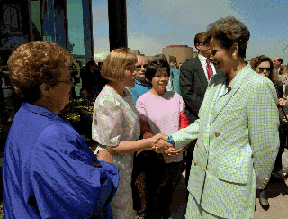

During her recent visit to LBL, Hazel O'Leary greeted laboratory employees in the courtyard of the Advanced Light Source
SECRETARY OF ENERGY HAZEL O'LEARY paid LBL a busy visit on June 30, which included a speech to Lab employees outside the Advanced Light Source. The Secretary was at the Lab to attend two high-level DOE meetings at LBL: a morning session with the heads of the nine national labs at the quarterly Lab Directors' Meeting, and a public meeting with the Secretary of Energy Advisory Board (SEAB).
At the midday speech, hundreds crowded on the ALS patio under sunny skies to hear O'Leary describe a DOE future driven by ambitious young scientists who will expand the country's economic capabilities at home and abroad through research and development. The speech focused on the immediate innovations DOE science can provide the U.S. economy. "Our challenge is to make what we produce in the U.S. of the highest quality, the best value for the dollar, for the franc, or for the drachma spent," she said. "It is to make products that are so technically correct for the problems they attempt to solve that anyone shopping in the global marketplace is compelled to buy them."
The stressing of DOE's contribution to the country's economic success comes in a year when the Galvin Task Force, a Secretary-appointed group of industry leaders, is carefully assessing the nine multi-purpose national labs. The group's mission involves, among other things, finding ways to strengthen ties between the national labs and the private sector. The Task Force will produce a final report that is expected to chart the future of the labs.
"The Galvin Task Force is taking the time to examine the laboratories not in a way that perceives that there is something bad about them, but that there is something powerful about them," O'Leary said. "When we put all the labs in a single pot, their combined capability in science, technology and engineering is larger than any in the private sector--larger than General Motors, the largest privately owned laboratory."
Central to the applied science push, she said, will be addressing the clean-up necessary after four decades of nuclear weapons research. "Our challenge is to develop methods to do this quickly and effectively, and to spin off technologies that have application in the worldwide marketplace."
The Secretary took several questions from the audience during the talk, including one about whether an increased emphasis on applied science might eclipse basic research. O'Leary answered that measurable results from lab projects are needed to guarantee the delivery of funds to support basic research. "The public would like immediate benefits," she said, "and it doesn't want to fund what it doesn't clearly understand. But we must articulate the vision that the public needs to make a leap of faith with us and continue to fund basic science."
O'Leary said she was particularly impressed by the student researchers she met during a tour of the ALS. They are testimony, she said, to the need of DOE to maintain its links with education. "We need to encourage, seduce, and outright bribe young, diverse minds to come here and do extraordinary work," she said.
Youthful enthusiasm, she said, will be an important driving force as DOE takes on the challenges facing it as it enters the next century. Said O'Leary: "I cannot think of a better example of this than LBL, where I see so many young, talented people focusing on the excitement involved with exploring science and technology."
Return to LBL Research Review Table of Contents